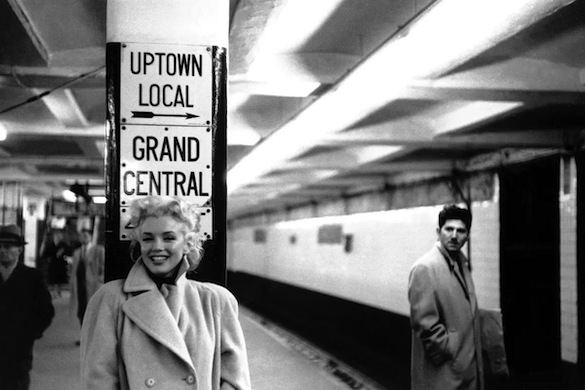‘Making Marilyn’: ‘An Actor Is Someone Who Does Things. An Actress Has Things Done To Her’
Julie Burchill on her new play about the iconic blonde, which is about to open at Brighton Palace Pier outside London.

In the United Kingdom, use of the word “iconic” has become utterly unreasonable. Once it meant a religious portrait; now the Cambridge Dictionary defines it as meaning “very famous or popular” and it brought me 1,680,000,000 results on Google including “iconic window cleaning” and “iconic sausage rolls.”
Few things, though, are actually iconic: The New York skyline, the Eiffel Tower, Mickey Mouse’s ears — and Marilyn Monroe, especially when standing over that New York air-vent in that white dress. In Britain, Big Ben, red buses — and Brighton Palace Pier, the most popular tourist attraction outside London, visited by millions of people every year.
Since last summer I’ve been writing — with my husband, Daniel Raven — a play called “Making Marilyn,” which takes place over 24 hours in a Manhattan hotel room on May Day in 1962 and will be performed on Brighton pier this May 2, 3, and 4, thus bringing three icons together at once.
I’ve adored Marilyn since I was a child, but reading about her this time I was struck by her love of New York City — how she saw it as a place to become an actor rather than an actress; as we have her say in our play:
“Hollywood was the place where I sewed marbles into my brassieres to make men think my nipples were pleased to see them; New York’s where I became an actor — not an actress, an actor. Have you ever thought about the difference between the two words? Actress could mean hooker, but actor never does. An actor is someone who does things. An actress has things done to her.”
New York had the Strasbergs and their Actors Studio — and Arthur Miller. The first she hoped would bring her the respect she craved as a public performer, the latter the happiness she sought in her private life. Both would turn out to be inconstant, but believing in them brought her a stay of execution — and with some intrinsically sorrowful lives, that’s the most that can be hoped for.
What other beautiful girls saw in the Hollywood Sign, Marilyn saw in the Statue of Liberty — a place to both escape a sub-standard start and paradoxically to become oneself by being born again in “the benediction of the neon lights,” to quote Jackson Browne.
“I grew up in L.A. Not up in Bel Air — down in the dumps,” our Marilyn says. “The other girls came from all over; they saw Hollywood as this magical kingdom where they were given everything they ever dreamed of but to me, it was a place where my mother went mad and I got dumped in an orphanage. It was only when I came here that I felt I’d arrived in some mythical city. Conquering it, like King Kong — if King Kong had worn a white dress and stood over an air vent on Lexington. I read Stanislavsky. Studied at the Studio with the Strasbergs. Went to therapy five times a week as acting preparation.”
With what we know now about therapy’s ability to perpetuate trauma, this probably wasn’t the wisest move and in time Method Acting became yet another thing for Marilyn to fret about; it was a double edged sword of Damocles. Before the fall, though, there was fun to be had.
In 1955, after breaking her contract with 20th Century-Fox, the 28-year-old Marilyn grabbed a black wig and the nom de plume Zelda Zonk and set up home at the Waldorf Astoria, her life no longer about beauty sleep and learning scripts but late nights at El Morocco, trips to the Met and Broadway premieres.
The literary set loved her, which must have made the girl whose biggest Hollywood bill was with a bookshop beyond happy. Her partner in crime was Truman Capote, as Elizabeth Winder wrote:
“They drank martinis at the Oak Room, daiquiris at the Waldorf, and champagne from the bottle at night in Central Park. They spent lazy afternoons in Chinese restaurants downtown, sipping lukewarm wine from water glasses filled with ice. Then they’d taxi through the Bowery to the South Street pier and feed seagulls crumbs of fortune cookies pulled from Marilyn’s purse.”
She loved Brooklyn — where Arthur Miller lived — the most, telling NBC in 1955 “Manhattan will be my home from now on — until I retire, and then I’ll return to Brooklyn. It’s my favorite place in the world; I haven’t traveled much but I don’t think I’ll find anyplace to replace Brooklyn … I just like walking around, and I think the view is better from Brooklyn … but it’s not just that, it’s the people. The people and the streets. I just like it.”
Even in the depths of despair, weighing up methods of suicide, she considers jumping off Brooklyn Bridge but concludes that the view is too beautiful from there so she couldn’t do it, suggesting that even in her most despairing mood she found something life-affirming about the city:
“Oh damn, I wish that I were dead — absolutely nonexistent — gone away from here — from everywhere — but how would I — there is always bridges — the Brooklyn Bridge —but I love that bridge — everything is beautiful from there and the air is so clean.”
She died in her home state in the first house she ever owned, called “Cursum Perficio” — the Latin for “My journey ends here.” She loved her little house, by all accounts. Yet if this bright, beautiful, bemused woman had stayed in her beloved New York City, maybe her journey would not have ended so soon.
“Making Marilyn” premieres on Brighton Palace Pier at Brighton, England, on May 2.

